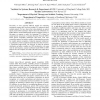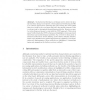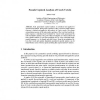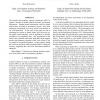113
click to vote
ICASSP
2011
IEEE
14 years 4 months ago
2011
IEEE
Previously we have proposed different models for estimating articulatory gestures and vocal tract variable (TV) trajectories from synthetic speech. We have shown that when deploye...
84
Voted
ICASSP
2011
IEEE
14 years 4 months ago
2011
IEEE
The motivation for this study is the need for careful analysis of aperiodicity of the excitation component in expressive voices. The paper proposes analysis methods which can pres...
95
Voted
INTERSPEECH
2010
14 years 7 months ago
2010
We present a novel automatic procedure to analyze articulatory setting (AS) or basis of articulation using realtime magnetic resonance images (rt-MRI) of the human vocal tract rec...
112
Voted
ICASSP
2009
IEEE
14 years 10 months ago
2009
IEEE
This paper applies two dynamic Bayes networks that include theoretical and measured kinematic features of the vocal tract, respectively, to the task of labeling phoneme sequences ...
99
Voted
CIT
2006
Springer
15 years 4 months ago
2006
Springer
In this paper we proposed some flexible methods, which are useful in the process of voice conversion. The proposed methods modify the shape of the vocal tract system and the chara...
107
Voted
NOLISP
2005
Springer
15 years 6 months ago
2005
Springer
Abstract. Glottal inverse filtering is a technique used to derive the glottal waveform during voiced speech. Closed phase inverse filtering (CPIF) is a common approach for achiev...
113
Voted
NOLISP
2005
Springer
15 years 6 months ago
2005
Springer
Real generalized cepstral analysis is introduced and applied to speech deconvolution. Real pseudo cepstrum of the vocal tract model impulse response is defined and applied to the a...
140
Voted
ICASSP
2007
IEEE
15 years 7 months ago
2007
IEEE
The article compares two approaches to the description of ultrasound vocal tract images for application in a “silent speech interface,” one based on tongue contour modeling, a...
114
Voted
ICASSP
2008
IEEE
15 years 7 months ago
2008
IEEE
Physiological properties of the glottis and the vocal tract change with age and gender. Since these changes are reflected in the speech signal, acoustic measures related to those...
95
Voted
ICASSP
2009
IEEE
15 years 7 months ago
2009
IEEE
The popular mel-frequency cepstral coefficients (MFCCs) capture a mixture of speaker-related, phonemic and channel information. Speaker-related information could be further broke...




